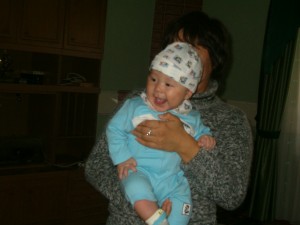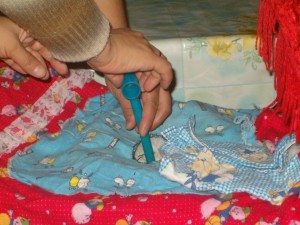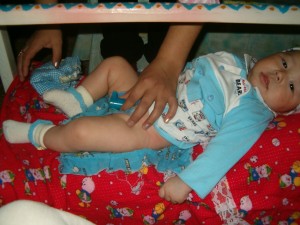Here, with no further ado, is my next-to-last deleted scene …
The Besik
That last year, the daily differences that had so overwhelmed me faded into the background and the universals stood out more easily. I remembered that all cultures have rituals around play, marriage (mating, at least), and child rearing. Homo sapiens, I knew, are (sorry; I know is is correct; I’m taking liberties) born with an inherent need to feel loved, valued, and secure.
Beyond wanting to survive, we need to know we belong, and where. We want to laugh and we want to raise happy, healthy children who grow up to contribute to their world in some way. But, again, the differences in how each culture achieves these ends can be fascinating. Or frightening; it’s all in one’s attitude.
Kazakh couples, I’d seen, share the same bed with their older children and never set a bedtime. Kazakhs wait to circumcise their sons, I’d heard, until age five. And, as I learned that winter, they swaddle their infants into their beds. Some of these practices were easier for me to accept than others.
“Like they did when they rode camels,” our site mate Jessica had told us, showing me the handout on the baby bed called a besik that she’d gotten during her training. The hand out that neither Woody nor I had gotten clearly stated the babies were indeed tied into their beds and left for hours. I wanted to know more, so I turned to Gulzhahan.
“We had a besik,” she told me matter-of-factly when I showed her the Peace Corps handout. “I used one with Duman, but it’s gone to my sister.” Each of my mother-colleagues, it turned out, had used this arrangement with each of their children. Since none of the children I’d met seemed any different from children in the US, except when it was 10:30 at night and they were still running around, I was determined to find out more.
Gulzhahan didn’t know the word “cradle,” so we couldn’t really talk about how the besik differed from the cradles I’d used with my sons. It took the news of the pending birth of my fourth grandchild for me to actually see my first one.
“You should buy one for David and Tara,” they told me. “Babies in this bed never have to have a diaper changed.” That part might appeal to my son and his wife, I thought, who were expecting their second child in December. If I could get the dimensions, I might even get my carpenter son Jon to build it for them. It was the tying-the-baby-into-it part that concerned me. I wanted to see one, so a few months after Gulzhan’s sister Marzhan had a baby, we went to her apartment to see hers.
Gulzhahan and I arrived to find Gulzhan already in her sister’s kitchen. The one-bedroom apartment was well furnished with the standard pieces I found in every home: the wall unit filling the long living room wall, the overstuffed sofa with matching overstuffed chairs, the TV — this one thankfully off — and the long, narrow dining table. As I passed the bedroom, I could see a baby in the middle of a big bed, cooing and watching his arms and legs flail in the air. The besik, it would seem, was at least not used full-time.
We ate, of course, before we saw anything. Gulzhahan and I helped lay the dastarkhan (set the table). I’d gotten quite good at laying a proper dastarkhan: containers of various drinks catty-corner on two ends, salad-sized plates centered at each place setting, bowls of baursak (fried bread) and multiple salads covering the tablecloth. There were no knives or forks, no salt or pepper, no condiments of any sort, but there were spoons and many bowls of candies within reach.
The meal was pleasant, but I was impatient to see the besik. Finally, Marzhan’s husband brought out a small white wooden cradle filled with baby blankets. Marzhan followed with her baby. Little Nursultan (named after President Nursultan Nazarbayev) was wide-awake, smiling broadly, and going easily to each set of arms, including mine.

Marzhan emptied the besik to get it ready to put Nursultan in, and I saw the significant differences from either of the cradles I had used: a hole in the wooden bottom and, instead of sides, the headboard and footboard of the “cradle” were connected by a single vertical slat of wood, conveniently positioned for use as a handle.

I watched Marzhan unwrap nine-month-old Nursultan and place him on his back into the empty besik, his bare bottom resting directly over the holes in both the tiny quilt that would soon enwrap him and the wooden besik.

Before she placed Nursultan into his besik, Marzhan wanted to show me what was going under Nursultan’s tiny pillow: a large and very sharp knife and packages of matches.

I phrased my inevitable “why?” carefully. “What do these items do?” I asked, trying to mask my horror.
“They will keep him from being frightened,” Gulzhahan translated.
I had no reply.

Deftly, Marzhan attached her anatomically intact son to a strategically placed rubber tube that dropped between his legs, through the hole beneath him, and into a pint-sized jar attached to the underside of the bed.
“How do you hook up a girl baby?” I asked as Marzhan’s hands continued to wrap.
“It’s no problem,” my colleagues chorused, laughing. “There’s a different shaped tube.”
“Can babies do all their ‘business’ through the same hole?”
They assured me they could.
Marzhan was wrapping thin sheets of cloth around her son, encircling him and pulling them taut under the bed, around and around, cocooning him so tightly to the besik, he was unable to wiggle. The term “swaddling clothes” came to mind, except he was being swaddled to the bed. Thick blankets completed the final layer while his eyes focused intently on his mother’s face. He did look cozy and quite content.

“However do you feed him?” I asked, expecting a simple translated explanation. Instead, after Gulzhan translated my question, Marzhan smiled, then knelt down next to the bed, hiked up her blouse and whipped out a breast. Tipping the besik toward her, she offered her son an unexpected snack. I showed her my camera and asked permission with a nod of my head.
“Kanyeshna” (Of course), she told me with a broad smile.

Snack time over, my colleagues helped me understand the history of the besik. Snug and safe — and apparently unafraid — nomad babies would travel in these beds for very long periods strapped to a camel. “How long do they stay in it today?” I asked.
“Up to eighteen hours,” I heard.
“How long will a family use the besik? How old are these babies when they stop?”
“Each family is different,” they told me. “Some will use it for more than a year.” Most babies stay in the besik until they begin to walk. Then it’s time for another feast, the Tusau Kesu, a ceremony where the toddler’s feet are bound with thread, then quickly cut by a specially chosen couple: Kazakh “Godparents,” I decided. Then everyone eats.

While we talked, Nursultan fell asleep, the picture of contentment. Still, I was not asking my son Jon to make one for his brother.
My sons and grandchildren are visiting this week and next. So, I’ve collected the last of my Deleted Scenes for my posts this week and next. I’d love to hear your stories of cultural differences that you found particularly hard. Could you find the common core across them?
Marian Beaman
A baby bedpan and feeding tube apparatus all in one. Well, I never!
The set-up works in this culture, the baby seems contented, so I’m not going to judge. I’m glad you keep “milking” more colorful stories from these fabulous years, Janet.
Janet Givens
Yes, Marian. I’m too am glad I can use these stories to underscore how important it is to keep our eye on the ultimate goal — safe, happy children. And, since this was another of those “WTF” moments when I first heard of it, I’m glad I checked it out.
Joan Z. Rough
Wow, Janet. This is absolutely fascinating and makes me wonder how each and every culture tends to their babies. What a book that would be!
Janet Givens
That would be a great book. Sounds like something I might cull from some of the Peace Corps groups I’m involved with. Thanks for the nudge.
Merril Smith
Fascinating! Although it seems weird to me, the baby is obviously loved and well-cared for. The whole set-up certainly makes sense for nomadic people. Your post reminds us that cultures can be different, but that there are many ways of living and of doing things, and no one way is right or wrong. Thanks for sharing.
Janet Givens
Hi Merril, Indeed. That is the message I try to get out as often as possible. To keep our curiosity alive in the process of understanding.
Now I’m off to read what you have written. Showers of Memories is a captivating title.
Shirley Hershey Showalter
Janet, it would be interesting to know what criteria you used for including or excluding scenes in your memoir. Maybe you already discussed these?
This scene, especially with the accompanying pictures, is so vivid. It also makes your point about cultural difference in a dramatic way. I admire the way you responded then and now.
Janet Givens
Oh, Shirley, These are some of my favorite scenes, my “darlings” if you will, as in “kill your darlings.” They were deleted from the book by my one of my editors at some point along the way, usually because whatever point I was making had already been made. It was a matter of maintaining pace. And it was painful. I’ve tried to post, over the past few years, most of these, particularly the ones I dearly loved. I have one more to go, then I hope to gather the ones I’ve posted here and put them into an eBook. Do you like the idea?